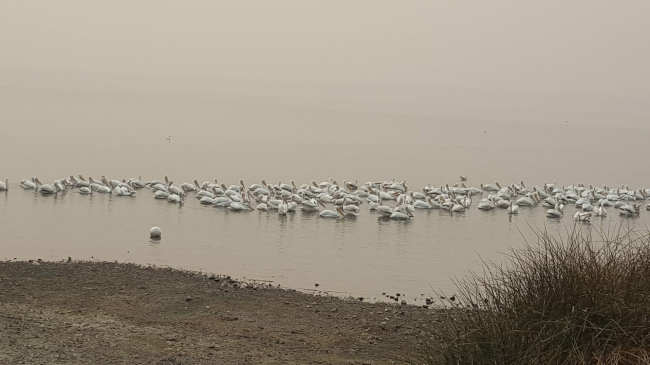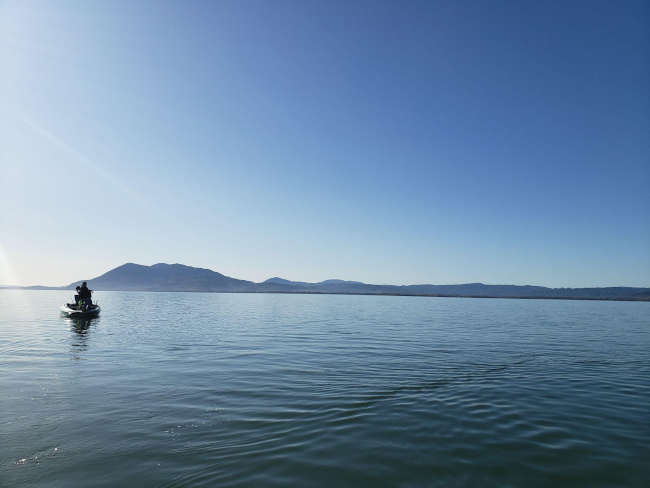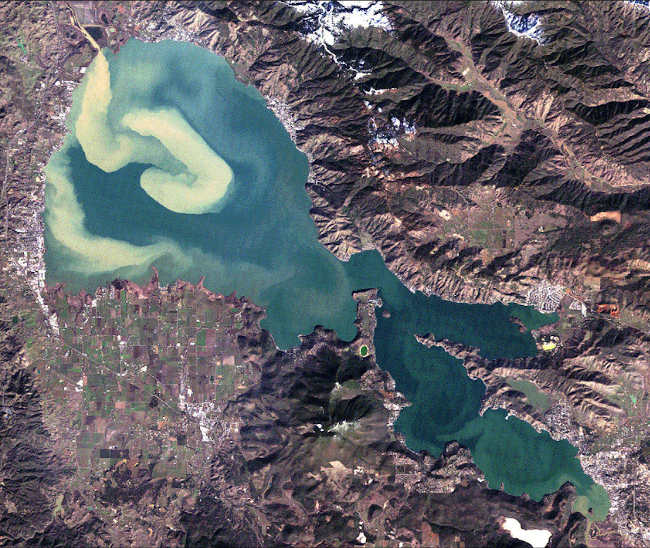
Dear Readers,
In today’s column, I won't be answering a question, but I will be describing why I am grateful for Clear Lake and why Clear Lake is so special. I am grateful for this column and the readers – you! – because without your questions, comments, inquiries, and readership I wouldn’t be able to learn about, teach, and explore this wonderful lake on digital paper every two weeks to a month.
Part of this column will contain excerpts from a speech I recently gave as the guest speaker at the Lake County Land Trust 30th Celebration Dinner on Oct. 28 at Boatique Winery in Kelseyville. I was asked to talk about why “The Lady of the Lake Loves Clear Lake” and for many of those things I love I am also grateful for, and so today's column and that speech have some overlapping content.
If you don’t know much about the Lake County Land Trust, I recommend you visit their website and learn about the many properties they have acquired that are essential to the protection of land and water in Lake County for future generations of people, plants, and animals to enjoy.
Also, if you are looking for a local, nonprofit organization to donate to this holiday season, the Lake County Land Trust will use your donation in high-impact ways such as acquisition, restoration, management, and educational stewardship of lands around Clear Lake and within Lake County.

Why Clear Lake is unique and special
Clear Lake is very special, especially to a limnologist. Technically, I am a limnologist by degree and by trade, meaning I study and work with inland freshwaters, like lakes, streams, wetlands, and ponds. Between all my academic, professional, and personnel experiences, I have probably been to over 1000 lakes in my life (one summer when I worked for the University of Notre Dame Center for Aquatic Conservation, our team visited 500 lakes in Ohio, Indian, and Illinois alone!), and I can still confidently say that Clear Lake is my favorite.
Clear is firstly unique and special because of her shape, containing three individual basins that express their own wind patterns and currents. This shape means that you can be in one part of the lake and have calm, quiet waters, and once you travel into another part, you will have turbulent waves or whitecaps. She has multiple personalities, mostly driven by her shape and form.
I talked about the formation and shape of Clear Lake in a previous column “Clear Lake Creation Story.” This column also describes how the lake has shifted watersheds by changing flows from south to north back to south again.
Clear Lake is really not like any other lake in the world, and while there are many reasons why she is special, from the perspective of a limnologist, I will present a few of the things that make her very special to me.
Clear lake is old and little studied compared to younger lakes
Historically, the field of limnology has been studied on large, deep lakes, usually in higher latitudes, think European countries, Canada, Wisconsin, Great Lakes, New York areas; these lakes also ice over during the cold, winter months.
To see an example of such lakes, visit website for the Canadian Experimental Lakes Area (https://www.iisd.org/ela/about/, now managed by The International Institute for Sustainable Development) which was established as The Freshwater Institute in 1966 to study important lake issues like acid rain and agricultural impacts to lakes in North America.
The term limnology was coined in 1868 by a swiss doctor studying Lake Geneva and in 1908, limnology was born in North America is the University of Wisconsin, Madison.
These type of lakes (i.e. northern latitude, cold, and deep) are essential to whole – lake manipulation and comparison studies (like those that determined that phosphorus is the nutrient that drives algal growth, and sometimes specific ratios or combinations of nitrogen and phosphorus are needed to drive algal growth).
Throughout the 20th century, these studied lakes provided valuable information and data that would lead to the basic foundational knowledge of limnology and lake management, but these lakes represent only a subset of lakes that exist in the world.
For example these lakes are located in cool-cold remote forest, boreal regions, they stratify during winter and summer and mix in spring and fall, and they ice over during winter. These lakes are also mostly oligotrophic or mesotrophic, or classified as low or medium in productivity, with relatively low baseline concentrations of nutrients and algae growth.
Information derived from these lakes might not apply or not apply in the same way for mediterranean lakes, tropical lakes, polymictic lakes, (more than two mixing events), shallow, or naturally eutrophic lakes. Clear Lake checks all the boxes in this list except for being tropical.
Additionally,many of these lakes are remnants of the last glacial retreat, which was fairly recent, in geological terms. In fact, the great lakes are only about 20,000 years old, and were formed by retreating continental glacial ice sheets.
Lakes in the midwest are slightly older, since they were at the edge of glacial retreat, and lakes in Canada are slightly younger as they were at the end of the retreat.
To put this in perspective, the area of Clear Lake has had a presence of water, as a lake, pond, wetland, and interconnecting streams, for about 2.5 million years. The Clear Lake we see today, has been in its general shape and form for about 500,000 years.
Clear Lake is older than most other North American lakes, and is probably the oldest freshwater lake. Mono Lake is a prehistoric lake, but is a saline soda lake.
While Clear Lake is old for North America, she is a toddler compared to some of the oldest lakes in the world. For example, Lake Zaysan in Kazakhstan is about 60 million years old and Lake Baikal in Siberia is about 25 million years old.
Age is just a number, right?
When it comes to age, the amount of time a lake has been around is very important. All the in-lake processes that contribute to the form and function of the lake, can be influenced by a lake’s age. For Clear Lake, this is especially true because she has a large, shallow basin.
The upper arm of Clear Lake is probably on a slow trajectory to becoming a very large marsh, and for lakes, this process can take a long, long time. First the basin has to become shallow, a physical process over time that requires the accumulation of sediments. Then the basin has to fill in with aquatic and wetland plants.
If you think about it, the upper arm collects sediments from the Middle-Scotts Creek subwatershed through Rodman Slough. There is even an island that formed outside of Rodman slough from the collection of sediment leaving the slough and during the drought, the land bridge at the mouth of Rodman Slough was populated by wetland plants and a refuge for waterfowl, otters, and deer.
During the summer months, the amount of aquatic and shoreline vegetation is significant, and in some areas poses a nuisance to boaters and water users that the county of Lake maintains a permitted aquatic plant management program to chemically treat and control submerged aquatic plants that can clog boat motors and propellers.
Through the shoreline development process over the last 100 years, about 50 percent of Clear Lake’s original wetlands were removed. Within the upper arm, before development, the shoreline probably comprised 50-200 feet wide stretches of tule, spikerush, smartweed, water lilies, and other emergent and floating leaf aquatic plant species. This plant community would creep inward and outward to coincide with the lake’s fluctuating water levels.

The large areas of shoreline vegetation were essential in presenting large sediment inputs from contributing large nutrient banks to the rest of the lake. The vegetation buffer would have trapped the sediment and nutrient inputs, and used them to build upon more vegetation, both as infrastructure and as a nutrient source.
Without the large vegetative shoreline around the lake, inputs are free to flow and move throughout the upper arm, getting picked up by currents and mobilizing throughout the rest of the lake. Check out this Science Friday post on the county of Lake Water Resources Department’s Facebook page describing the currents throughout Clear Lake.
Now, without the vegetative shoreline around the lake, large inputs, from storms mostly, can contribute nutrient-rich sediment into the lake, which can serve as a ready-made food source for cyanobacteria and algae.
In fact there have been so many inputs into the lake, that the lake has built up a large nutrient sediment bank at the bottom of the lake. This means that additional inputs, while important, are not a large contributor as the nutrients already stored in the sediment bank. This is also unique to Clear Lake.
Most of the lakes I mentioned earlier in the column, that formed the basis of limnological study, would respond quickly to manipulated inputs from external sources, meaning that if an external source of nutrients or sediments was completely removed, the lake would rebound and algae growth would lessen. Remember, these are experimental lakes, so researchers did manipulate lakes by adding large doses of nutrients just to see what would happen or not happen.
Clear Lake is different. Even when there are large, but sporadic, inputs of soils and sediments, like from a wildfire, they don’t have much impact on the internal lake nutrients, especially phosphorus concentrations.
Last year, working with partner limnologists from Michigan State University and Dartmouth College, we conducted a research study on the impacts of wildfire and climate change in the Clear Lake basin. We published the paper in the online, public access journal Ecosphere (Vol 13, issue 12).
We found that climate change impacts, including low winter rain, warmer winter temperatures are associated with increased phosphorus in the water column (where it can feed cyanobacteria and algae) and wildfires are not.
When we looked at the phosphorus concentrations in the water column of all three arms, three years before and three years after major wildfires in the Clear Lake basin (1982, 1996, 2018), we did not see any differences.
Meaning that phosphorus concentrations didn’t change, didn’t increase or decrease, before or after large wildfires, during the time period that we have in-lake phosphorus water quality data (1968-2020). Data used for this study can be found from the Department of Water Resources Data water library.
This is a unique finding for lakes, as most other lakes studied for wildfire impacts are highly impacted by fires occurring in their basin, but Clear Lake is not. She has probably evolved with wildfires over time, and the highly eutrophic nature of her water quality, already enriched with phosphorus, is unaffected by a wildfire here or there. And this is just one more thing that makes Clear Lake unique and special.
Clear Lake vs. Reservoirs
I receive many questions, both through my Lady of the Lake email, and my phone at my day job for County of Lake Water Resources, but the most common question I get is probably, “how and when is the lake going to be cleaned?”
This is a difficult question, in several ways. Let’s think about a useful follow up question, what does a “clean” lake look like? If you close your eyes and picture this in your mind, what does it look like to you?
If you described blue, clear, cold water, then you probably need to evaluate what your perception of a large, shallow, old, and naturally formed freshwater lake looks and acts like.
Most of the time, when people describe their ideal “cleaned up” lake, they are describing reservoirs. And, of course we can’t compare Clear Lake to reservoirs, which are at most 90 years old. In fact, according to the FEMA National Inventory of Dams, the average age of reservoirs (that are dammed) is only 61 years.
When you think about it, a 61 year old lake is a baby, infant lake. Clear Lake is surrounded by these baby, reservoir lakes, such as Barryessa, Folsom, Shasta, Mendocino and Sonoma, just to name a few.
These baby lakes are flowing systems really, that are almost completely drained each year and refilled with fresh and clean rain water. Reservoirs are drained from the bottom, which allow any built up sediments and nutrients in the water column to also flow out the dam intake and down river, sometimes powering hydroelectric facilities.
Clear Lake, has a natural outflow, over the Grigsby Riffle at a narrow point in Cache Creek. This outflow point is at the top of the water column actually. Any water that flows down Cache Creek, leaving Clear Lake, is from the surface, like a pitcher of water filled to the top – the top will leave the pitcher through the spout if overfilled. The bottom water will remain in the pitcher unless enough water is added to overflow at the spout.
This means that, generally, any materials that flow into the lake from the rivers, creeks, or urban areas, can basically remain in the lake forever because they sink and settle to the bottom and the only point of water that is leaving the lake is from the surface of the lake to about 7 feet, or when the lake stops flowing down through Cache Creek and over the Grigsby Riffle.
This concept is really important when comparing Clear Lake to reservoirs and understanding why Clear Lake will never, ever look or act like a reservoir.
To make the analogy clear, reservoirs are brand new, shiny, right out of the box, like a slip n’ slide, with clean hose water moving over the plastic. Clear Lake is an above ground pool that has been left outside for 500,000 years. Clear Lake actually looks pretty good, considering this analogy. But no wonder she is green and full of life!
No other lake in the world is like Clear Lake. She is fascinating and complicated. Restoring her to her prior glory, whatever that might be, it’s still being determined, will take a long time, and a highly collaborative effort.
This complicated uniqueness of Clear Lake is what makes her so special, and why I love being able to work on this fascinating system. There will always be a need for further research on Clear Lake, because she is so unique and not like any other lakes out there. This is why I am grateful for Clear Lake, and thankful that I get to write about her in the Lake County News.
Sincerely,
Lady of the Lake
Angela De Palma-Dow is a limnologist (limnology = study of fresh inland waters) who lives and works in Lake County. Born in Northern California, she has a Master of Science from Michigan State University. She is a Certified Lake Manager from the North American Lake Management Society, or NALMS, and she is the current president/chair of the California chapter of the Society for Freshwater Science. She can be reached at This email address is being protected from spambots. You need JavaScript enabled to view it..

 How to resolve AdBlock issue?
How to resolve AdBlock issue? 





